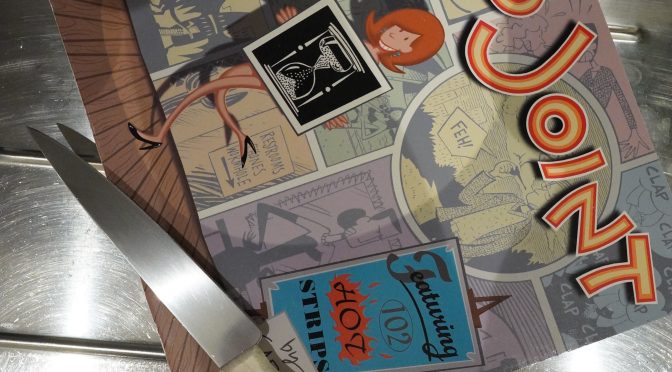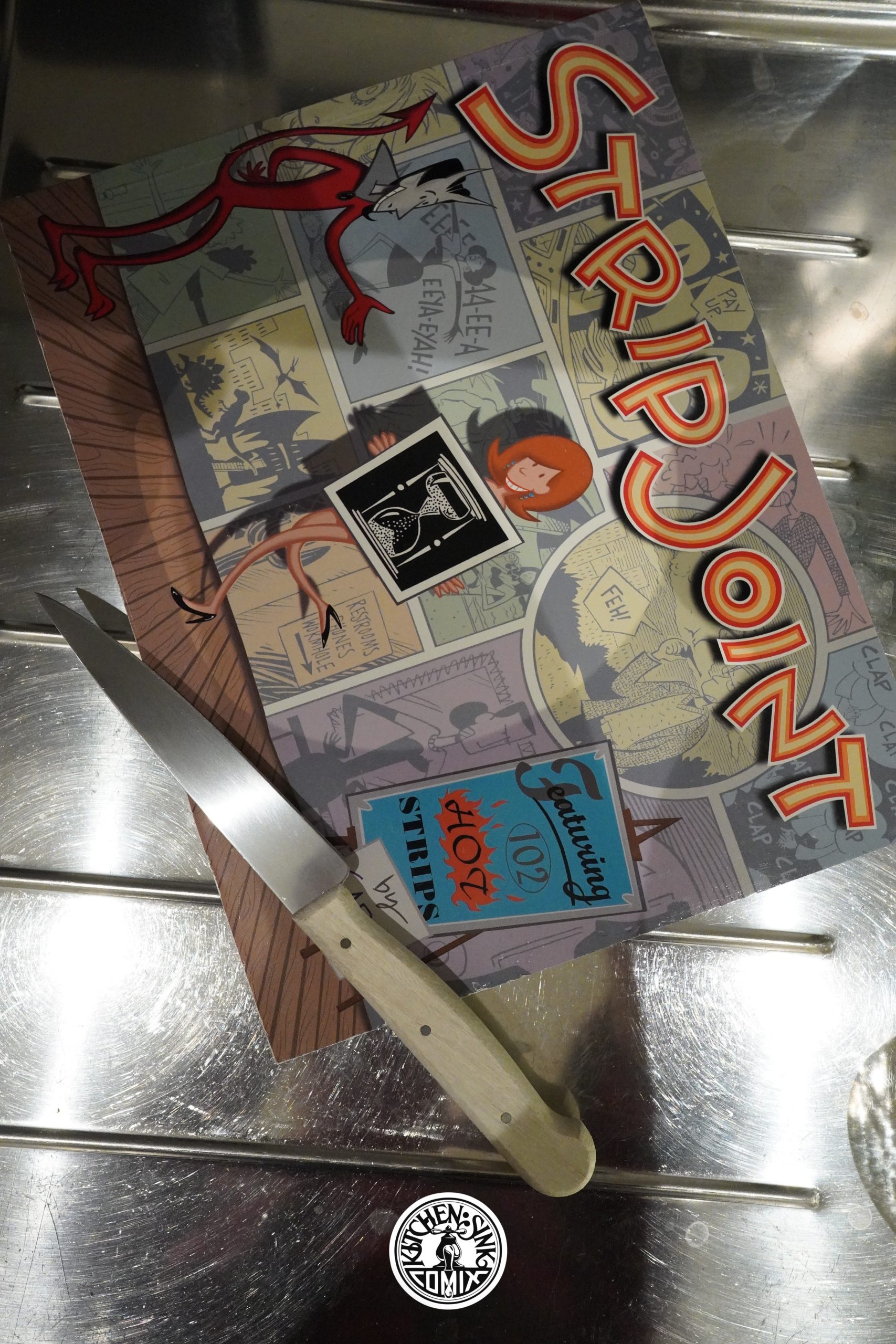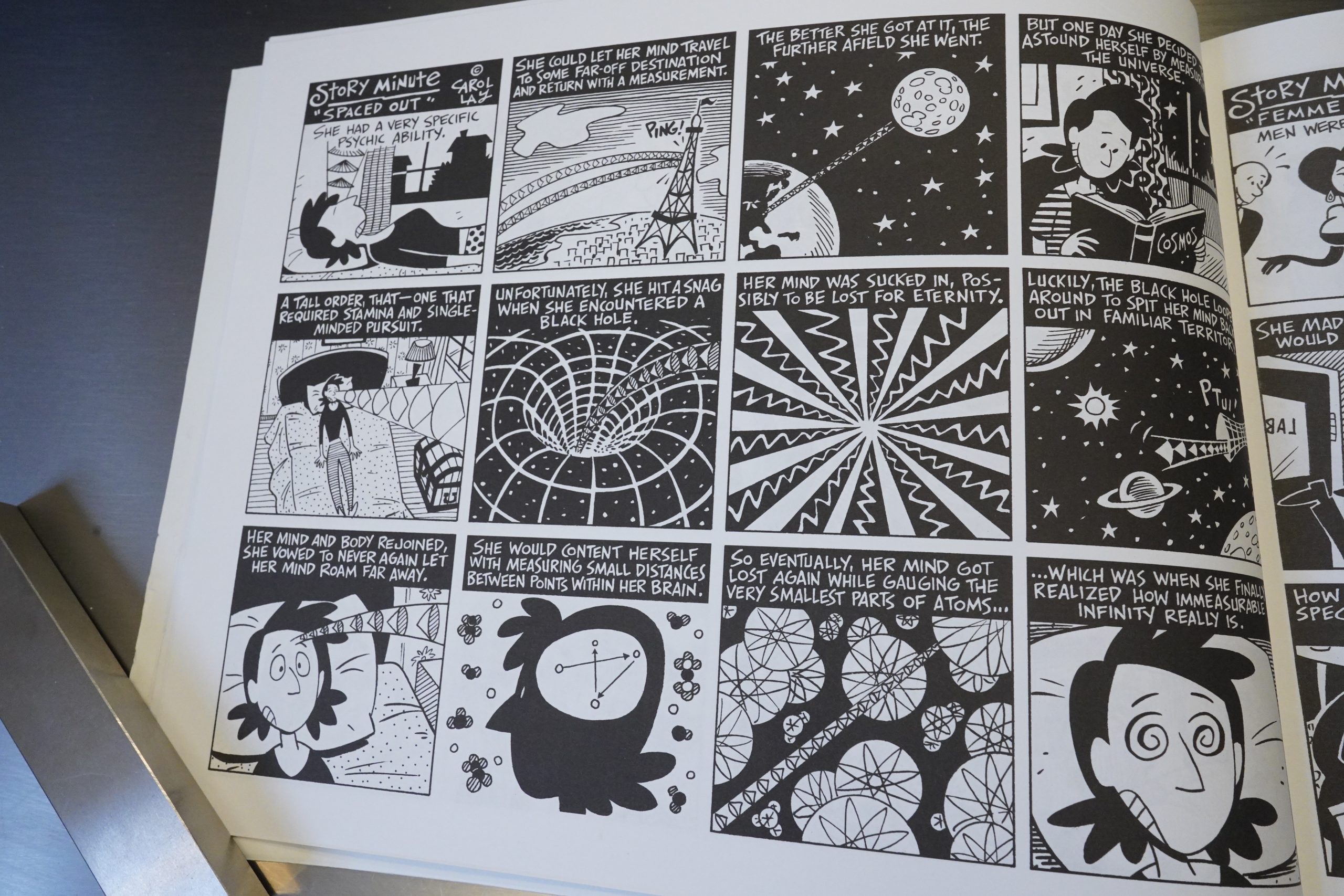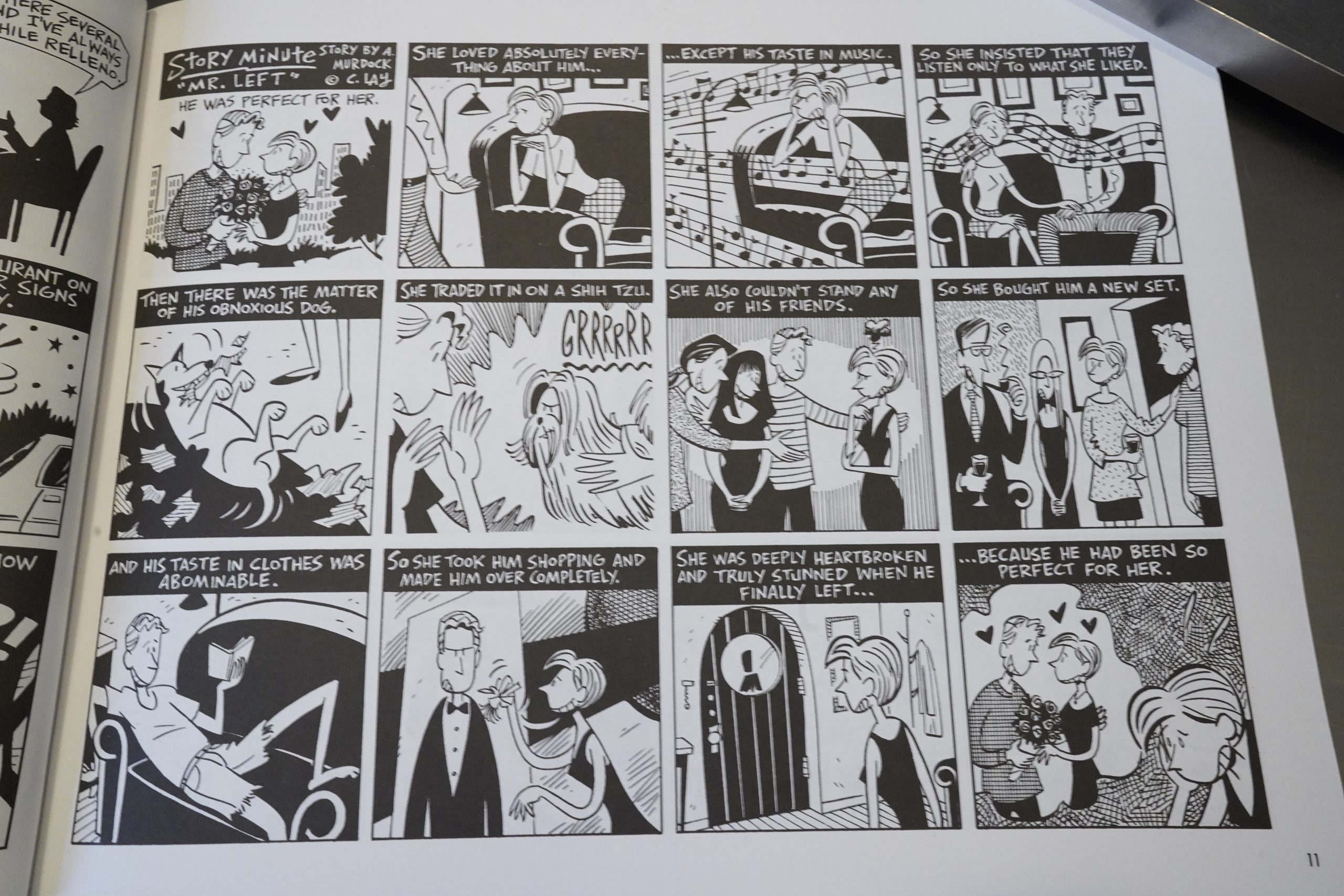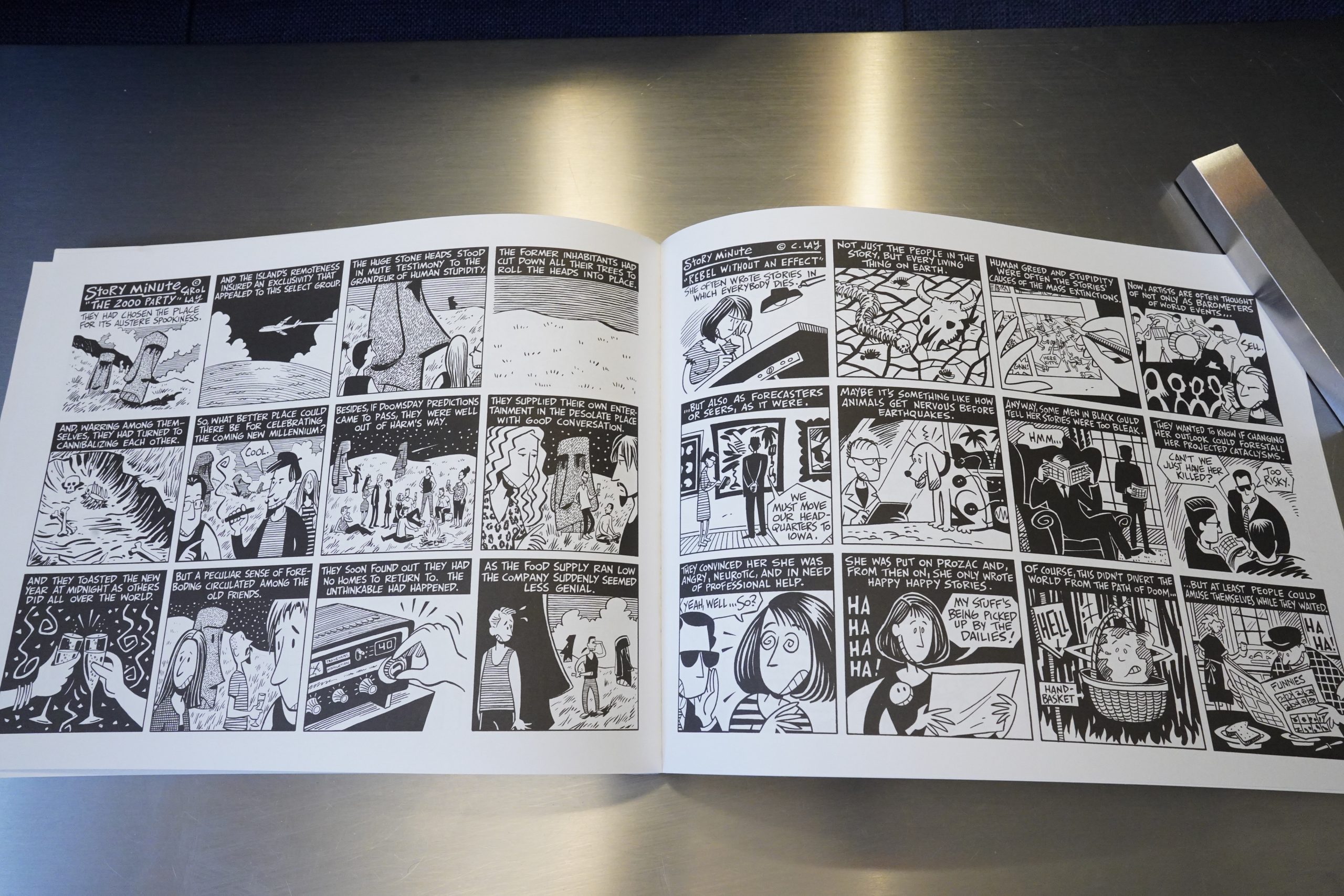Strip Joint (1998) by Carol Lay
I was a huge fan of Carol Lay’s Good Girls comics back in the 80s, but I was mostly nonplussed by her Story Minutes strip. It’s just me, not the strip — I have zero affinity for fairytales, and I have an active antipathy towards recaps — and a typical Story Minute strip reads like a recap of a fairytale.
So it’s just not my thing? But I do see that it’s smart and well made, and lots of people love recaps and fairytales, so I don’t wonder at all at its popularity.
Mark Evanier provides an amusing introduction — he’d apparently been her first editor back in the days.
This collection covers the last half of the 90s — I think this was a weekly series, so since this is just 100+ pages long, that either means that this is a “best of” thing, or it didn’t appear weekly. (Might be holidays or something…?)
Many of these strips are designed to make you go “huh” more than “hah”.
And while most of the strips are pretty well-made (even if not my thing), some of them just seem to devolve to common platitudes.
And there’s a definite mean streak, for better or for worse.
There’s one recurring character, and I wonder why Lay didn’t use her more. People love recurring characters.
I guess the strips are presented chronologically, but it doesn’t really say. But it’d make sense if the Y2K strip was from 98, like.
Lay is interviewed in The Comics Journal #213, page 77:
WORCESTER: Do you want to talk about the books that
came out ontory Minute? Tie experience ofworking on
the three books?
LAY: Working with Kitchen Sink was delightful and
really sorry that they’re gone.
WORCESTER: Was Denis your editor?
LAY: No. Chris Couch edited the books, although Phil
Amara did the first before he left for Dark Horse. I
always got good input from the art department. Actu-
ally, Denis had some good input on the cover art for Joy
Ride. In Strip Joint, I pretty much just nailed that
thing. I had existing art in here and I just colored it,
drew it a bit bigger, and scanned it in. It’s all done
digitally. Ids a good cover in that sort Ofgag in itself.
You see the front ofthe stage, this quaint, risque little
strip scene on the front, and then the back cover is a
scene in the backstage ofthe same place. It was a lot of
fin to do — easy, because of the computer.
WORCESTER: The cover of Strip Joint is gorgeous. Were
you worried that it wouldmislead readers, make it look like
a sexier book than it is?
LAY: Yes, but there are a couple naked ladies in there…
Ray Mescallado writes in The Comics Journal #208, page 56:
Carol Lay’s Story Minute is the only comic
strip 1 100k forward to every week; I Click
to its World Wide Web home at Salon
Magazine every Tuesday like clockwork.
so the release Of Lay’s third collection of
strips is definite reason to rejoice. While
StripJ0intisa slightly different beast from
the earlier Now, Endsville and Joy Ride, it
has all the charm, thoughtfulness and
humor of those previous volumes.
What makes Lay a compelling strip
artist are two things: balance and respon-
sibility. She tells great jokes, but you
know that her jokes are trying to convey
an important point. Or to take it from
another angle: she has a point, but you
trust her enough to convey it through
and the first two collections is the lack of
a longer, sustained narrative. While there
are a few mini-arcs, none last longer than
a half-dozen strips: we don’t have any-
thing approaching the title stories of the
first two volumes. This absence leaves me
ambivalent. Those longer stories anchored
the last two books and gave them a recog-
nizable narrative heft that’s lacking in
Strip Joint. On the other hand, it becomes
clear in this volume that Lay’s strength is
in the one-off strips, that the short bursts
Create the best pay-offs. Without a Now,
Endsville or Joy Ride showcasing Lay’s
skills, it also becomes easier to sort through
the individual strips and judge them on
individual merit.
The good strips Stand out that much
more: Lay’s formula is to start with a
purposefully silly premise, steadily in-
crease the absurdity of the situation, then
deliver a whammy with a last-panel
punchline irony. This is the case with
such gems as “Odd Odds,” “No Time to
Kill” and “Babyface.” Perhaps the best
example is “Dillusing It,” which is about
ful heroine — with Lay’s laid-back,
schmoozy Devil the perfect foil — the
Manichean nature Of their relationship is
overplayed in this volume, reaching its
nadir in a mildly amusing trio of strips
where each champions a different cosmi-
cally-empowered painter. The premise is
more original than another trio of strips in
this volume, in which the Devil hosts a
game show where contestants sell their
souls —
but this mini-arc is even less
satisfying by ending on a predictable stale-
mate.
Even Lay’s less sucessful strips have
an energy and playfulness that make them
worth a quick read. The reason is Lay’s
art: engaging and distinctive, its surface
looseness and simplicity grabs the reader
with Lay’s now-signature “big teeth”
stylings. The visual expressiveness Of
Story Minute comes from this dental cen-
tering: it limits the range Of expression
on her characters’ faces, but in a way that
ultimately serves her particular brand Of
satire. The long-in-the-tooth look popu-
lates Lay’s strips with blank-staring fools,
some great jokes. Lay is fasci-
nated by the politics Of the world
— personal and Otherwise — but
also has a clear desire to tell a
story, to entertain the reader and
not just harangue her.[…]
Characters may be good, bad or
indifferent — but at heart they’re all na-
ive: in that naivete, in the characters’
inability to think out the consequences Of
their actions, lies much of Lay’s humor
and message. It isn’t so much about fool-
ish choices but the way such foolishness
expands and swallows up the characters,
their relationships, often the world itself.
Not that Lay feels duty-bound to this
visual style: she’ll rein in the teeth on
certain strips, such as “Address Book,”
where it would seem inappropriate. But
Lay is certainly correct in observing that
the stylistic leap she made was an impor-
tant step in her development: we now
have three excellent volumes to confirm
this.
Lay’s cartooning is brilliant, charming and expressive. Any initial concerns about her characters all having huge overbites evaporate almost instantly as you’re drawn into her hyper-imaginative world of delights.
The best part about this strip is that she avoids ever being preachy, which is a difficult thing with her wide range of topics. Looks like I have another strip to read every week on Salon,
This is the two hundred and fourteenth post in the Entire Kitchen Sink blog series.
